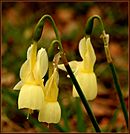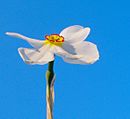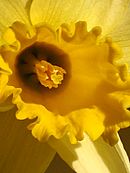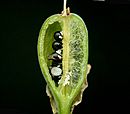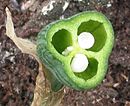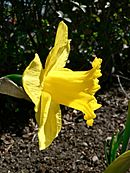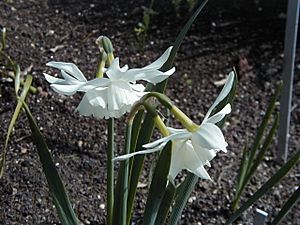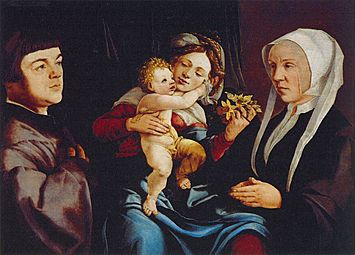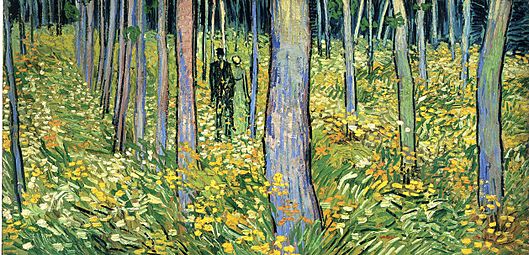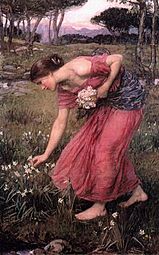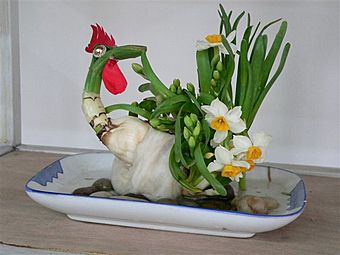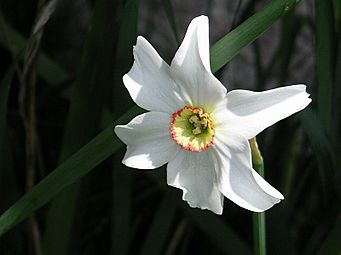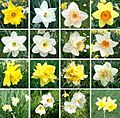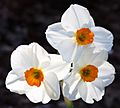Narcissus (genus) facts for kids
Quick facts for kids Daffodil |
|
|---|---|
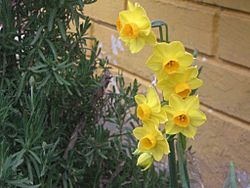 |
|
| Narcissus pseudonarcissus flower | |
| Scientific classification | |
| Kingdom: | |
| Division: | |
| Class: | |
| Order: | |
| Family: | |
| Genus: |
Narcissus
|
Narcissus is a group of plants that come back every year, mostly in spring. They belong to the Amaryllidaceae family, also known as the amaryllis family. You might know them by common names like daffodil, daffadowndilly, narcissus, or jonquil.
Daffodils have pretty flowers with six petal-like parts called tepals. In the middle, they have a cup or trumpet-shaped part called a corona. Their flowers are usually white or yellow. Garden varieties can also be orange or pink. Sometimes, the tepals and corona have different colors.
People have known about daffodils for a very long time, even in ancient times. They were used for medicine and studied by botanists. Carl Linnaeus officially described them in his book Species Plantarum in 1753. There are about 50 different types (species) of daffodils.
These plants naturally grow in meadows and woods in southern Europe and North Africa. Many different types are found in the Western Mediterranean, especially in Spain and Portugal. Wild and cultivated daffodils have spread widely. They were even brought to Asia before the 900s.
Daffodils grow from bulbs that can live for a long time. They spread by dividing their bulbs. Insects also help them pollinate. Some common problems for daffodils include viruses, fungi, and tiny pests like fly larvae, mites, and nematodes. Sadly, some daffodil species have disappeared, and others are in danger because of cities growing and more tourism.
People have been growing daffodils for a very long time. They became much more popular in Europe after the 1500s. By the late 1800s, they were an important crop, especially in the Netherlands.
Today, daffodils are popular as cut flowers and as ornamental plants in gardens and parks.
What Do Daffodils Look Like?
General Features
Daffodils are perennial plants that grow from bulbs. This means they die back after flowering but grow again from an underground bulb the next year. They have brown, egg-shaped bulbs with long necks. Depending on the type, they can grow from 5 to 80 centimeters tall. For example, tiny N. asturiensis is only 5-8 cm tall, while Narcissus tazetta can reach 80 cm.
The plants have a single, hollow flower stem (called a scape) with no leaves on it. Several green or blue-green, narrow, strap-shaped leaves grow from the bulb. The stem usually has one flower, but sometimes it has a cluster of flowers (an umbel). The flowers are usually white or yellow, but can be both, or rarely green.
Each flower has three main parts. Close to the stem is a floral tube above the ovary. Then there's an outer ring of six tepals (which are like petals and sepals combined). In the center is a cup or cone-shaped corona. The flowers can hang down or stand upright. Inside, there are six pollen-carrying stamens around a central style. The ovary (where seeds form) is below the flower parts and has three sections. The fruit is a dry capsule that splits open to release many black seeds.
The bulb rests underground after the leaves and flower stem die. It has special roots that pull it deeper into the soil. The flower stem and leaves grow inside the bulb, ready to appear next season. Most daffodils are dormant from summer to late winter and bloom in spring. However, a few types flower in autumn.
Plant Parts in Detail
Bulbs and Roots
Daffodil bulbs are egg-shaped with pale brown skin. They have a corky base plate from which thin root hairs grow. These roots can be up to 40 mm long. Above the base plate, the bulb stores food in layers called scales. The bulb can contain several smaller bulb units, each lasting about four years.
When the leaves die in summer, the roots also dry up. After some years, the roots shorten, pulling the bulbs deeper into the ground. New layers grow inside the bulb, pushing older layers outwards to form the dry outer skin. Even when the plant looks dormant above ground, the flower stalk for the next spring grows inside the bulb, surrounded by leaves.
Stems
The single, leafless stem (scape) appears from early to late spring, depending on the species. It holds 1 to 20 flowers. The stem's shape varies; some are flat with a visible seam, while others are round. Stems stand upright in the center of the leaves. In some species, like N. hedraeanthus, the stem is slanted. The upper part of the stem is hollow, but closer to the bulb, it's more solid and filled with spongy material.
Leaves
Daffodil plants have one to several leaves that grow from the base. They are long and narrow, like straps, and can be flat or rounded at the base. They grow from the bulb. Young plants usually have two leaves, but mature plants typically have three, sometimes four. The leaves are covered with a waxy layer, giving them a slightly shiny look. Their color ranges from light green to blue-green. In mature plants, the leaves are usually taller than the flower stem, but in some types, they hang low. After flowering, the leaves turn yellow and die back when the seed pod is ripe.
Jonquils, a type of daffodil, usually have dark green, round leaves that look like rushes.
Where Do Daffodils Grow?
Natural Homes
While most plants in the Amaryllidaceae family grow in tropical or subtropical areas, daffodils mainly grow in the Mediterranean region. The largest variety of daffodils is found in the Iberian Peninsula (which includes Spain and Portugal).
Some species also grow in southern France, Italy, the Balkans, and the Eastern Mediterranean, including Israel.
Daffodils found in western and central Asia, China, and Japan are thought to have been brought there by people a very long time ago. Similarly, wild daffodils in Great Britain and northern Europe are also believed to be old introductions.
Even though daffodils are not native to North America, they grow well in most parts of the United States and Canada.
Preferred Habitats
Daffodils grow in many different natural places. They can be found at various elevations, in different climates, and on different types of soil. They mostly prefer open areas, from low marshes to rocky hillsides and mountain pastures. You can see them in grassland, scrub, woods, river banks, and rocky crevices.
While their needs vary, most daffodils prefer acidic soils. However, some types can grow on limestone. For example, Narcissus scaberulus grows on granite soils that are wet in spring but dry in summer. Narcissus dubius grows best in areas with hot, dry summers.
How Daffodils Live and Grow
Life Cycle
Daffodils are long-lived perennial plants that grow from bulbs. They grow in winter and are dormant in summer. Their leaves and flowers usually appear at the same time. Most species flower from late winter to spring. However, five species flower in autumn, and their leaves appear after the flowers.
Flowers can last from 5 to 20 days, depending on the species and conditions. After flowering, the leaves and roots start to die, and the plant appears to be resting until the next spring. During this resting period, a lot of activity happens inside the bulb, preparing for the next growing season.
Daffodils can spread by growing new bulbs from the main one, forming clumps. Different daffodil species can also easily hybridize (cross-breed), creating new types. The ability of their offspring to have babies depends on how closely related the parent plants are.
Pollination
Daffodil flowers are pollinated by insects. The main pollinators are bees, butterflies, flies, and hawkmoths. The highly scented N. viridiflorus, which flowers at night, is pollinated by moths that are active at dusk.
Daffodils in History and Gardens
Early Pictures
-
N. serotinus, from John Gerard's The Herball (1597)
-
N. poeticus, from Thomas Hale's Eden (1757)
-
Daffodils, from John Parkinson's Paradisus Terrestris (1629)
Bulb plants have always been popular for growing. Among these, daffodils are one of the most important spring-flowering bulb plants in the world.
Daffodils became a major horticultural crop in Western Europe in the late 1800s. This started in England between 1835 and 1855 and later in the Netherlands by the end of the century. By the early 1900s, 50 million "Paperwhite" daffodil bulbs were sent from the Netherlands to the United States every year.
Today, daffodils are popular as ornamental plants for gardens and parks, and as cut flowers. They bring color from late winter to early summer in temperate regions. They are one of the most popular spring flowers and a major crop for both their bulbs and cut flowers. More daffodils are grown in private and public gardens than for commercial sales.
Over a hundred years of plant breeding have created thousands of different types (cultivars) of daffodils. You can buy them from general and special plant stores. They are usually sold as dry bulbs to be planted in late summer and autumn. Daffodils are one of the most important ornamental plants for the economy. Plant breeders have made some daffodils with double, triple, or many layers of petals. Many breeding programs have focused on the corona (the trumpet or cup), changing its length, shape, and color.
Growing Daffodils in Gardens
Some wild daffodils need very specific conditions to grow. However, most garden varieties can handle different soil types. If the soil is very wet or made of clay, adding sand can help it drain better. The best soil for daffodils is neutral to slightly acidic, with a pH of 6.5–7.0.
Bulbs sold for planting are called 'round' or 'double nose'.
Daffodils are great for planting under small groups of trees, where you can put 6–12 bulbs together. They also grow well in flower borders, especially with day lilies. Day lilies start to grow their leaves just as daffodils finish flowering.
How Daffodils are Propagated
The most common way to grow new daffodils for sale is by twin-scaling. This involves cutting the bulbs into many small pieces. Each piece must have two scales still connected by a small part of the bulb's base. These pieces are then cleaned and placed in a special growing mix. About 25–35 new plants can be grown from one bulb after four years using this method. Other advanced methods are used to create the initial stock for commercial growing.
Daffodils in Culture
Symbols and Meanings
The daffodil is the national flower of Wales. It is linked to Saint David's Day on March 1st. The narcissus is also a national flower in Iranian culture, symbolizing the new year or Newroz. It means wealth and good fortune.
In Western countries, the narcissus is sometimes seen as a symbol of vanity, based on the Greek myth. But in Eastern cultures, it means wealth and good luck. In Persian literature, the narcissus symbolizes beautiful eyes.
In Western countries, the daffodil is also connected to spring festivals like Lent and Easter. In Germany, the wild daffodil, N. pseudonarcissus, is called the Osterglocke or "Easter bell." In the United Kingdom, it's sometimes called the Lenten lily.
Even though daffodils are beautiful, some people think they bring bad luck because their heads hang down, which can suggest misfortune. White daffodils, like N triandrus "Thalia", are especially linked to death and have been called grave flowers. In Ancient Greece, daffodils were planted near tombs. The poet Robert Herrick wrote about them as signs of death. This idea also appears in the myth of Persephone and the underworld.
Daffodils in Art
Ancient Times
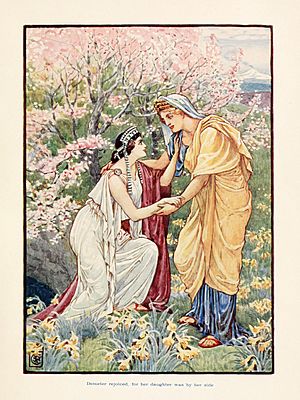
Daffodils have been used as decorations since the time of ancient Egyptian tombs and frescoes in Pompeii. They are mentioned in the Bible and appear often in old classical writings.
Greek Stories
The narcissus flower appears in two Greek and Roman myths. One is about a young man named Narcissus who was turned into the flower. The other is about the goddess Persephone, who was taken to the Underworld by the god Hades while picking flowers. The narcissus is considered special to Hades and Persephone and is said to grow along the river Styx in the underworld.
The Greek poet Stasinos mentioned them in the Cypria as flowers of Cyprus. The story of Persephone is mostly known from the 7th century BC Homeric Hymn to Demeter. In it, the author describes the narcissus and how it was used to trick young Persephone. She tells her mother that the narcissus was the last flower she reached for before being captured.
Other Greek writers like Sophocles and Plutarch also wrote about the narcissus. Sophocles used the narcissus in a symbolic way, suggesting fertility and linking it to the worship of Demeter and her daughter Persephone. It also became a symbol of death. Just as Persephone reaching for the flower led to her capture, young Narcissus looking at his own reflection led to his death.
Roman Stories
Virgil, one of the first known Roman writers to mention the narcissus, did so in several places. He wrote about the cup-shaped corona of the daffodil flower, which was said to hold the tears of the self-loving youth Narcissus. The poet Ovid also wrote about the myth of the narcissus. In his Metamorphoses, he tells the story of the youth Narcissus who becomes the flower after his death.
Western Culture
![]() wandered lonely as a Cloud
wandered lonely as a Cloud
That floats on high o'er Vales and Hills,
When all at once I saw a crowd
A host of dancing Daffodils;
Along the Lake, beneath the trees,
Ten thousand dancing in the breeze.
The waves beside them danced, but they
Outdid the sparkling waves in glee: –
A poet could not but be gay
In such a laughing company:
I gaz'd – and gaz'd – but little thought
What wealth the shew to me had brought:
For oft when on my couch I lie
In vacant or in pensive mood,
They flash upon that inward eye
Which is the bliss of solitude,
And then my heart with pleasure fills,
And dances with the Daffodils.
Even though the flower's name might not directly come from the Greek myth, the connection between the flower and the myth became a strong part of Western culture. The narcissus or daffodil is a very loved English plant and appears often in English literature. Many English writers have written about the cultural and symbolic meaning of daffodils. Only the rose and the lily have been written about more in poetry. Poets like John Gower, Shakespeare, Milton, Wordsworth, Shelley, and Keats have written about them. Often, the poems talk about self-love, inspired by Ovid's story.
Shakespeare, who often uses flower images, mentions daffodils twice in The Winter's Tale and also in The Two Noble Kinsmen. Robert Herrick hints at their link to death in some of his poems. Among the English romantic writers, William Wordsworth's short 1804 poem I Wandered Lonely as a Cloud is very famous. It is now strongly linked to the daffodils it describes. Wordsworth also included daffodils in other poems.
In visual arts, daffodils are shown in three ways: in myths (Narcissus, Persephone), as floral art, or in landscapes. The Narcissus story has been popular with painters, and the young man is often shown with flowers to highlight this connection. The Persephone theme is also seen in Waterhouse's Narcissus. The floral design is shown by Jan van Scorel, and the landscape by Van Gogh's Undergrowth.
Daffodils first appeared in Western art in the late Middle Ages, especially in panel paintings that showed the crucifixion. For example, in a painting in the Wallraf-Richartz-Museum in Cologne, daffodils symbolize not only death but also hope in the resurrection. This is because they are perennial and bloom around Easter.
-
Jan van Scorel: Madonna of the Daffodils with the Child and Donors, 1535
-
Vincent van Gogh: Undergrowth with Two Figures, 1890
-
Waterhouse: Narcissus, 1912
Eastern Cultures
In Chinese culture, Narcissus tazetta subsp. chinensis (Chinese sacred lilies) are widely used as ornamental plants and can be grown indoors. They were likely brought to China by Arab traders on the Silk Road before the Song Dynasty for medicinal use. Since they flower in spring, they became linked to Chinese New Year, symbolizing good fortune, prosperity, and good luck. There are many legends about daffodils in Chinese culture. Unlike in the West, daffodils haven't been a big part of Chinese Garden art. However, Zhao Mengjian in the Southern Song Dynasty was known for painting daffodils. Carving and growing daffodil bulbs has become an art form, similar to Japanese bonsai.
Islamic Culture
Daffodils are one of the most popular garden plants in Islamic culture. Before the Arab conquest of Persia, the Persian ruler Khosrau I reportedly didn't like them at feasts because they reminded him of eyes. This connection to eyes still exists today, as described by the poet Ghalib. The eye imagery is also found in poems by Abu Nuwas. Another poet who mentions daffodils is Rumi. Even the prophet Mohammed is said to have praised the narcissus.
Popular Culture
The word "daffodil" has been used in many ways in popular culture. It's been used for Dutch cars (DAF Daffodil) and Swedish rock bands (The Daffodils).
Festivals
In some areas where daffodils grow a lot, their blooming in spring is celebrated with festivals. For example, the hills around Montreux, Switzerland, come alive with blooms every May during the annual Narcissi Festival, known as May Snow. Festivals are also held in many other countries.
Helping Others
Various cancer charities around the world use the daffodil as a symbol for fundraising. Organizations like the American Cancer Society, Cancer Society, Cancer Council, Irish Cancer Society, and Marie Curie in the UK use it for "Daffodil Days" to raise money for cancer research and support.
Images for kids
-
N. candidissimus by Pierre-Joseph Redouté, 1808
-
N. major, N. triandrus and N. jonquilla. Encyclopaedia Londinensis 1819
-
N. juncifolius, Carolus Clusius Rariorum stirpium 1576
-
N. poeticus, Matthias de l'Obel Icones stirpium 1591
-
Range of Narcissus cultivars
See also
 In Spanish: Narcissus para niños
In Spanish: Narcissus para niños









